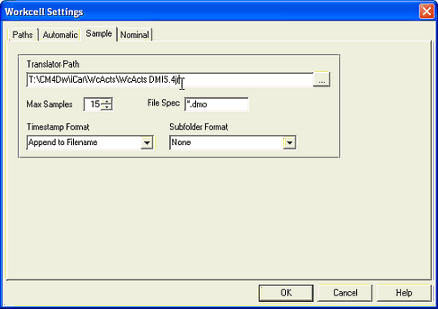The Sample tab settings in Workcell are very similar to those for DataSmith Batch (i.e. File Spec, Timestamps, and Subfolders).

Translator Path
The translator path must point to the location of the translator file that will process the sample files. The *.4datasmith file can reside in any local folder; it does not have to live in the Workcell home folder.
Max Samples __
The maximum number of samples to keep loaded for the queries is the value Workcell uses as a target for the number of Samples to be displayed at a given time. This is not a hard limit, as the number of samples in a query may be more or less than the target, depending on the circumstances.
The following examples assume that all data coming into Workcell is for the same Routine for which the user has either a Static Query already set up for, or a Dynamic Query in the startup document:
When Query Load brings in more samples than the Maximum Number of Samples:
When a Query is created in the Workcell startup template, you set the number of samples you want to load by default. This number may or may not be the same as the target number of Samples in the Workcell settings. For this example, assume you have selected to load the last ten Samples in the Query and set the Maximum Number of Samples to keep loaded to five. When Workcell is initially opened, the last ten Samples (if ten are available) will be loaded from the database. In this situation, the first time you load and commit a sample from within Workcell, the number of Samples in the Query will drop to the target value of five (four from the database and one from Workcell).
When Query Load brings in fewer samples than the Maximum Number of Samples:
If you set the target number of Samples to keep to five, but the Query load default is only set to three, only the last three Samples will be loaded from the database when Workcell starts. In this case, you will then load data one Sample at a time into Workcell, so that after two Samples are read in it will have reached the target number (five). When the user loads the next Sample, the oldest sample in the Query will automatically be removed from the Query because it is data that came from the database (and so by definition is already in the database). Workcell will still be displaying its target number of Samples (five).
If the above step is repeated two more times, the Query will now have un-committed Samples in it (meaning all of the samples in the Query have been read in via Workcell). Assuming you have not committed any of the data, when the next Sample gets read in Workcell will add it to the Query and will NOT remove a Sample because it has not yet been committed. This will continue to happen (pushing the number of Samples in the Query as far beyond the target number as you wish) until the oldest Sample in the Query has been committed. The total number of Samples in the Query will correlate to the number of Samples handled sequentially.
File Spec
File Spec determines which files will be considered for processing in Workcell. Wildcard usage such as '*.*' are acceptable.
Timestamp Formation
The Timestamp Format determines where the timestamp will be placed within the filename:

- Append to Extension - "filename.xml_dd-mm-yy_hh-mm-ss"
- Prefix to Filename - "dd-mm-yy_hh-mm-ss_filename.xml"
- Append to Filename - "filename_dd-mm-yy_hh-mm-ss.xml"
Subfolder Format
This determines if and where files will be placed at the end of their processing life-span. The current options are:

- None - no subfolders will be created; all files will be in the Outbox
- Day - each file processed in an entire day will be placed in that day's subfolder
- Month - each file processed in an entire month will be placed in that month's subfolder